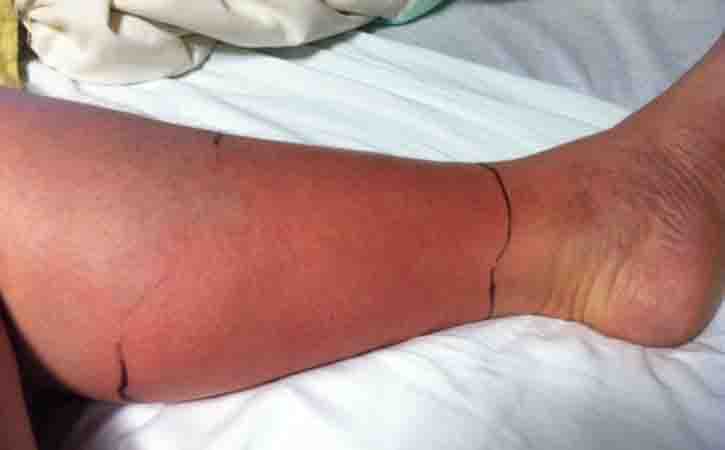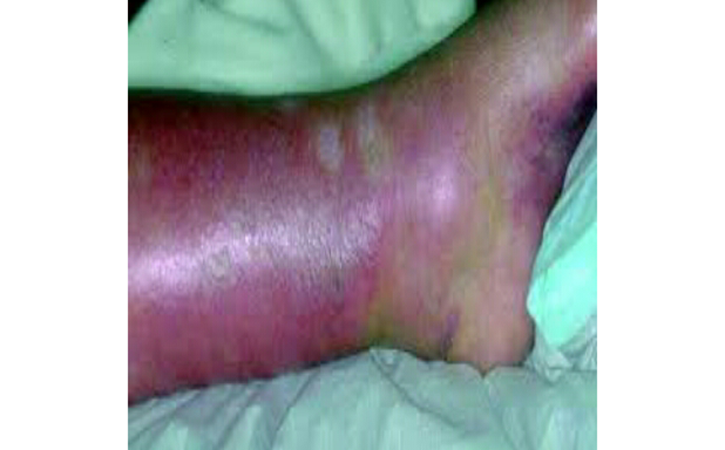Cellulitis
Cellulitis is a suppurative inflammation involving the subcutaneous tissue. Usually, but not always, this follows some discernible wound. Cellulitis is a common infection of the skin. It happens when bacteria enter a break in the skin and spread. Bacterial infection may spread in dermis (the deep layer of skin) as well as the subcutaneous tissues, the fat and soft tissue layer that are under the skin. Some types of bacteria are naturally present on the skin and do not normally became harm.

Bacteria can enter through cuts, grazes, or bites. The legs are most commonly affected. It can start suddenly, and it can become serious if not treated. If it spreads deeper into the body, it can be life-threatening.
People with conditions, such as eczema or psoriasis may have a higher risk of developing cellulitis. Cellulitis nearly always responds rapidly to antibiotics.
Cellulitis can affect any part of the body, but it is most likely to appear in the lower legs. It is a painful condition.



The symptoms of cellulitis may include:
- pain in the affected area,
- inflammation of skin,
- a skin sore or rash that appears and grows quickly,
- a tight, glossy, swollen appearance of the skin,
- a feeling of warmth in the affected area,
- a central area that has an abscess with pus formation,
- a fever.
Some common symptoms of a more serious cellulitis infection are:
- shaking,
- chills,
- fatigue,
- dizziness,
- lightheadedness,
- muscle aches,
- warm skin,
- sweating,
You should contact your doctor immediately if any of these symptoms occur.
Cellulitis occurs when bacteria, most commonly streptococcus and staphylococcus, enter through a crack or break (like: injury, insect bites, or surgical incisions) in your skin. The incidence of a more serious staphylococcus infection called methicillin-resistant Staphylococcus aureus (MRSA) is increasing.
Although cellulitis can occur anywhere on your body, the most common location is the lower leg. Bacteria are most likely to enter disrupted areas of skin, such as where you’ve had recent surgery, cuts, puncture wounds, an ulcer, athlete’s foot or dermatitis.
Animal bites can also a cause of cellulitis. Bacteria can also enter through areas of dry, flaky skin or swollen skin.
Cellulitis needs early treatment. Early treatment with antibiotics is usually successful. It may treat at home, but sometimes need in hospital treatment. Initial empiric therapy with dicloxacillin or cephalexin for 5 days will usually suffice.
Treatment includes:
- Immobilize the affected area.
- Elevate the area. So that, it can help to reduce swelling and relieve discomfort.
- Use medication for pain relievers such as acetaminophen or ibuprofen to ease the pain, as well as keep fever down.
If the infection isn’t too bad, patient can take antibiotics by mouth for a week to 14 days. Doctor will schedule a follow-up appointment. Doctor may use IV or intramuscular antibiotics if:
- The infection is severe.
- Other medical problems.
- Very young or very old.
- The cellulitis covers large areas, is on hands, or is close to body parts like eyes.
- The infection worsens even after taking antibiotics for 2 to 3 days.
In serious cases, may need to stay in the hospital. It will treat by IV antibiotics until the infection is under control (2 to 3 days), and then oral medicines may help.
Surgery for Cellulitis
Rarely, severe cases may need surgery. For example, doctors may need to open and drain an abscess or pus that has collected in the tissue. They may also need to cut away dead tissue to allow healing.
It’s important to identify and treat cellulitis early because the condition can spread rapidly throughout the body. Contact a doctor when suspected a symptoms arises.
Clinical Dermatology
Roxburgh’s common skin diseases
Andrew’s Diseases of the skin
Cellulitis
TUI - Tibot Urgency Index


Cellulitis is a suppurative inflammation involving the subcutaneous tissue. Usually, but not always, this follows some discernible wound. Cellulitis is a common infection of the skin. It happens when bacteria enter a break in the skin and spread. Bacterial infection may spread in dermis (the deep layer of skin) as well as the subcutaneous tissues, the fat and soft tissue layer that are under the skin. Some types of bacteria are naturally present on the skin and do not normally became harm.



Bacteria can enter through cuts, grazes, or bites. The legs are most commonly affected. It can start suddenly, and it can become serious if not treated. If it spreads deeper into the body, it can be life-threatening.
People with conditions, such as eczema or psoriasis may have a higher risk of developing cellulitis. Cellulitis nearly always responds rapidly to antibiotics.
Cellulitis can affect any part of the body, but it is most likely to appear in the lower legs. It is a painful condition.



The symptoms of cellulitis may include:
- pain in the affected area,
- inflammation of skin,
- a skin sore or rash that appears and grows quickly,
- a tight, glossy, swollen appearance of the skin,
- a feeling of warmth in the affected area,
- a central area that has an abscess with pus formation,
- a fever.
Some common symptoms of a more serious cellulitis infection are:
- shaking,
- chills,
- fatigue,
- dizziness,
- lightheadedness,
- muscle aches,
- warm skin,
- sweating,
You should contact your doctor immediately if any of these symptoms occur.
Cellulitis occurs when bacteria, most commonly streptococcus and staphylococcus, enter through a crack or break (like: injury, insect bites, or surgical incisions) in your skin. The incidence of a more serious staphylococcus infection called methicillin-resistant Staphylococcus aureus (MRSA) is increasing.
Although cellulitis can occur anywhere on your body, the most common location is the lower leg. Bacteria are most likely to enter disrupted areas of skin, such as where you’ve had recent surgery, cuts, puncture wounds, an ulcer, athlete’s foot or dermatitis.
Animal bites can also a cause of cellulitis. Bacteria can also enter through areas of dry, flaky skin or swollen skin.
Cellulitis needs early treatment. Early treatment with antibiotics is usually successful. It may treat at home, but sometimes need in hospital treatment. Initial empiric therapy with dicloxacillin or cephalexin for 5 days will usually suffice.
Treatment includes:
- Immobilize the affected area.
- Elevate the area. So that, it can help to reduce swelling and relieve discomfort.
- Use medication for pain relievers such as acetaminophen or ibuprofen to ease the pain, as well as keep fever down.
If the infection isn’t too bad, patient can take antibiotics by mouth for a week to 14 days. Doctor will schedule a follow-up appointment. Doctor may use IV or intramuscular antibiotics if:
- The infection is severe.
- Other medical problems.
- Very young or very old.
- The cellulitis covers large areas, is on hands, or is close to body parts like eyes.
- The infection worsens even after taking antibiotics for 2 to 3 days.
In serious cases, may need to stay in the hospital. It will treat by IV antibiotics until the infection is under control (2 to 3 days), and then oral medicines may help.
Surgery for Cellulitis
Rarely, severe cases may need surgery. For example, doctors may need to open and drain an abscess or pus that has collected in the tissue. They may also need to cut away dead tissue to allow healing.
It’s important to identify and treat cellulitis early because the condition can spread rapidly throughout the body. Contact a doctor when suspected a symptoms arises.
Clinical Dermatology
Roxburgh’s common skin diseases
Andrew’s Diseases of the skin




